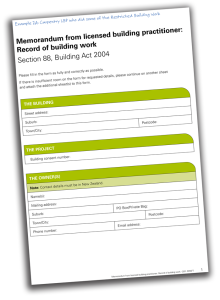Managing memorandums
30 Sep 2014, Building and housing, Featured, Prove Your Know How

MBIE addresses issues with Records of Work (Building) and Certificates of Work (Design)
Over recent months, MBIE has identified a trend where some licensed building practitioners (LBPs) are withholding records of work (RoWs) and certificates of work (CoWs), until milestone or contractual payments have been met by their client or lead contractor. This practice has led to approximately 12% of all LBP complaints made to the Building Practitioners Board (BPB) being about a failure to supply a RoW. A number of disgruntled homeowners and local authorities have also contacted the Ministry directly to convey their concerns about such practices.
This article aims to clarify the legislative requirements, encourage consistent processes and foster good practice among LBPs, who are involved in issuing memorandums for restricted building work (RBW).
Where a building consent is being applied for, or building work is being undertaken as part of a building consent, the Building Act 2004 (the Act) requires that:
- Design work that is RBW should be accompanied with a CoW, which must have been completed by the LBP or LBPs who carried out or supervised that design work. The CoW should state that the design work either complies with the building code or whether (and what) waivers or modifications of the building code are required (sec 45 (3) of the Act).
- Each LBP who carries out or supervises RBW must, on completion of the RBW, provide the owner and the council with a RoW, stating what RBW the practitioner carried out or supervised (sec 88(1) of the Act). This process is not applicable where an owner-builder is undertaking the building work under an owner-builder exemption.
For design work, this means a CoW should legally accompany all RBW, which forms part of a building consent application. For building work, this means a RoW should legally be provided to the owner and the council when the consented building work has been completed by the LBP.
“Most importantly, practitioners should not align or leverage contractual or milestone progress payments with issuance of prescribed forms (memorandum),” says LBP registrar Paul Hobbs. “While we understand the motive, the memorandum is legally required to be handed in at specific and defined times during the building consent process.”
In summary, LBPs should not withhold a memorandum ‘without good reason’, as they potentially open themselves up to being investigated and disciplined under section 317(d) of the Act.
“LBPs should not withhold a memorandum ‘without good reason’, as they potentially open themselves up to being investigated and disciplined under section 317(d) of the Act
Completing memorandums
A number of local authorities have also reported that some memorandum being lodged as part of building consent applications are incomplete, or on occasion lack sufficient detail regarding the particulars of the RBW they cover.
When completing memorandums for RBW, care should be taken to complete the form correctly, as it will remain with the building consent for the life of the building it relates too. The Ministry has previously provided guidance on completing CoWs under the RBW regime, which can be found at on the MBIE website under ‘Certificate of Work’ guidance.
This guidance provides several examples of completed memorandums and outlines the level of detail considered necessary to accurately complete these forms. See the example below.

When completing a memorandum, it’s important that LBPs provide sufficient detail to clearly distinguish their building work from other practitioners, who may have worked on the same project
When completing a memorandum, LBPs should ask themselves if they are providing sufficient detail to clearly distinguish their building work from other practitioners, who may have worked on the same project. In short, when completed, the memorandum should clearly represent a practitioner’s output or contribution in terms of the RBW they cover.
Finally, some councils have reported that designers are often failing to complete the ‘waiver or modification’ sections found in the CoW. Although it is fairly uncommon to seek a waiver or modification of the Building Code, this part of the form should clearly outline whether a waiver or modification is being sought under the building consent application. Appendix C in the ‘Certificate of Work’ guidance mentioned above shows examples of forms completed correctly.
It’s worth noting that completing the form in the correct manner could prevent unnecessary delays during the building consent process.
Register to earn LBP Points Sign in



